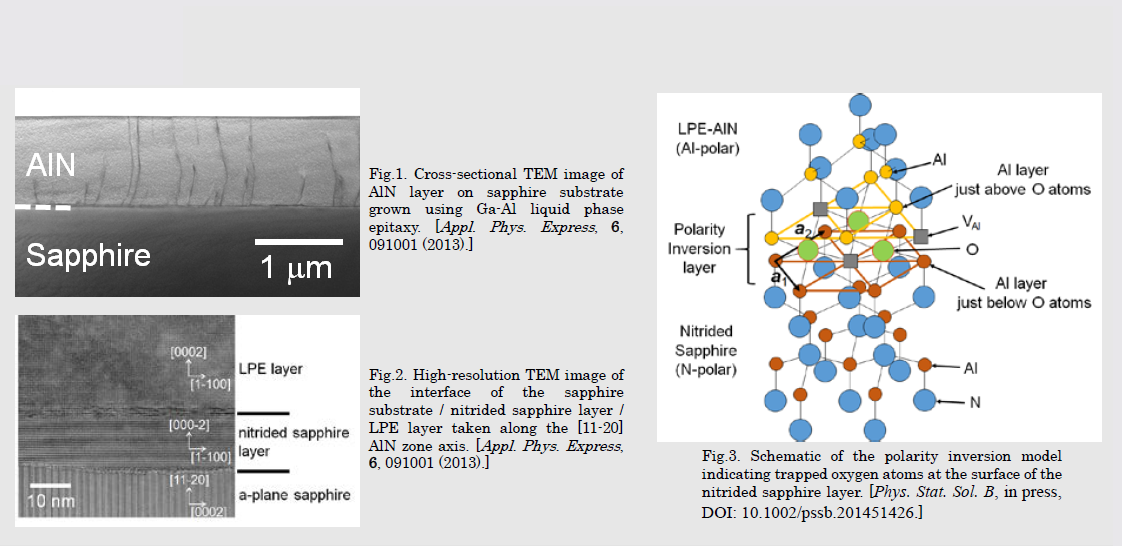
IMRAM
Institute of Multidisciplinary Research for Advanced Materials, Tohoku University
東北大学
多元物質科学研究所

LAST UPDATE 2021/05/06
-
研究者氏名
Researcher Name安達正芳 Masayoshi ADACHI
講師 Lecturer -
所属
Affiliation東北大学 多元物質科学研究所
金属資源プロセス研究センター 高温材料物理化学研究分野
Institute of Multidisciplinary Research for Advanced Materials, Tohoku University
Center for Mineral Processing and Metallurgy, High-temperature Physical Chemistry of Materials -
研究キーワード
Research Keywords結晶成長
窒化物結晶
液相成長
高温融体物性
Crystal growth
Nitrides
Liquid phase epitaxy
thermophysical properties of liquid metals
- 研究テーマ
Research Subject -
Ga-Al フラックスを用いた単結晶窒化アルミニウムの液相成長
Liquid phase epitaxial growth of single crystalline AlN using Ga-Al solution
研究の背景 Background of the Research
AlGaN系LEDは,GaNとAlNの混合比により,3.4から6.2eVまでの範囲で発光波長を選択できるため,殺菌光源や樹脂硬化光源等,幅広い用途での使用が期待されています.このAlGaN系LEDの基板として,AlGaNとの格子整合性が高く且つAlGaNよりも広いバンドギャップを有するAlN単結晶が最適な材料です.しかしながら,これまで結晶のサイズおよびコストの両方を同時に満足する製造プロセスは確立していません.
AlGaN-based LEDs are expected to have various applications, because the emitting photon energy can be tuned from 3.4 to 6.2 eV by selecting composition ratio of GaN and AlN. As a substrate for AlGaN-based LEDs, AlN is a good candidate because of its wide bandgap and small lattice mismatch with AlGaN. However, fabricating larger diameter bulk AlN crystals at reasonable cost has not been achieved to date.
研究の目標 Research Objective
AlGaN系深紫外LED用の基板の実用化を目指し,Ga-Alをフラックスとして用いた独自の液相エピタキシャル成長法を開発し,表面を窒化したサファイア基板上へのAlN単結晶成長技術の開発を行なっております.これまでの研究により,10mm角の基板ながら,1573K,5hのプロセスで厚さ1.2㎛の高品質AlN単結晶の育成に成功しています.現在,大型化・高速成長化に関する研究とともに,結晶成長機構の解明を目指した研究を行っており,本手法の実用化を目指しています.
We have developed an original liquid phase epitaxy (LPE) method using Ga-Al flux. In this method, 1.2-㎛-thick AlN can be grown on surface nitrided sapphire substrate at 1573 K for 5 h. Recently, we attempt to grow larger-diameter AlN, moreover, we attempt to clarify the growth mechanism of AlN for this LPE method.
研究図Figures

論文発表 / Publications
Phys. Stat. Sol. B, published online, DOI:10.1002/pssb.201700478. Mater. Trans., 58, 509 (2017). Phys. Stat. Sol. B, 252, 743 (2015). Appl. Phys. Express, 6, 091001 (2013). Appl. Phys. Express, 5, 101001 (2012). Phys. Stat. Sol. A, 208, 1494, (2011). J. Mater. Sci., 45, 2002 (2010).
研究者連絡先 / HP
- masayoshi.adachi.d7
 tohoku.ac.jp
tohoku.ac.jp - http://www2.tagen.tohoku.ac.jp/lab/fukuyama/